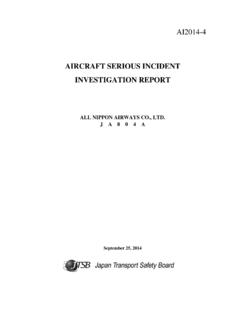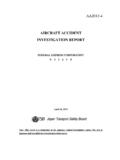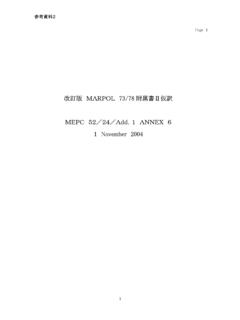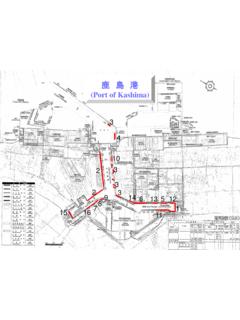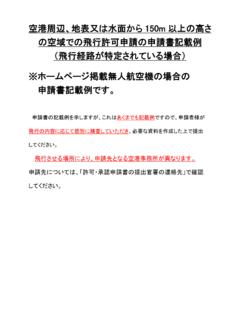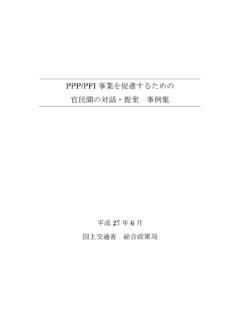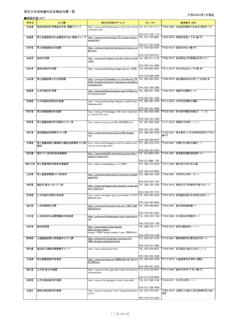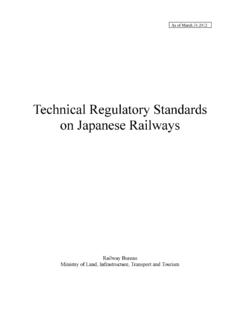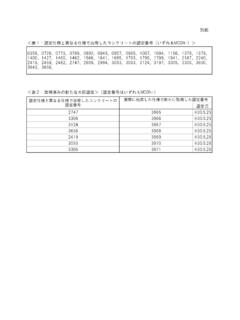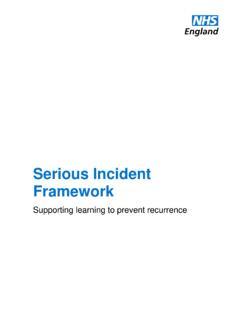Transcription of AIRCRAFT SERIOUS INCIDENT INVESTIGATION REPORT
1 AI2018-1 AIRCRAFT SERIOUS INCIDENT INVESTIGATION REPORT PEACH AVIATION CO., LTD. J A 8 1 1 P February 22, 2018 The objective of the INVESTIGATION conducted by the Japan Transport Safety Board in accordance with the Act for Establishment of the Japan Transport Safety Board (and with Annex 13 to the Convention on International Civil Aviation) is to prevent future accidents and incidents. It is not the purpose of the INVESTIGATION to apportion blame or liability. Kazuhiro Nakahashi Chairman, Japan Transport Safety Board Note: This REPORT is a translation of the Japanese original INVESTIGATION REPORT . The text in Japanese shall prevail in the interpretation of the REPORT . AIRCRAFT SERIOUS INCIDENT INVESTIGATION REPORT PEACH AVIATION CO., LTD. AIRBUS A320-214, JA811P ATTEMPTED LANDING ON A CLOSED RUNWAY ABOUT 5 NM EAST OF TOKYO INTERNATIONAL AIRPORT AROUND 480FT AT 00:39 JST, DECEMBER 22, 2016 January 12, 201818 Adopted by the Japan Transport Safety Board Chairman Kazuhiro Nakahashi Member Toru Miyashita Member Toshiyuki Ishikawa Member Yuichi Marui Member Keiji Tanaka Member Miwa Nakanishi SYNOPSIS <Summary of the SERIOUS INCIDENT > On Thursday, December 22, 2016, an Airbus A320-214, registered JA811P, operated by Peach Aviation Co.
2 , Ltd, as the scheduled Flight 1028 of the company, while approaching runway 16L of Tokyo International Airport, mistakenly tried to approach for runway 23 which was closed at 00:39 JST. An air traffic controller in the control tower noticed the situation and instructed it to go around at the position of about 5 nm east of the airport. Afterward, the AIRCRAFT landed on runway 16L at 00:55 JST via visual approach following radar-vectored. There were 164 persons on board consisting of the captain, five other crewmembers and 158 passengers. Nobody was injured and there was no damage to the AIRCRAFT . <Probable Cause> It is probable that the SERIOUS INCIDENT occurred because AIRCRAFT , conducting VOR-A approach to land on runway 16L of Tokyo International Airport, mistakenly tried to approach for runway 23 which was closed. It is probable that the AIRCRAFT mistakenly tried to approach for runway 23 which was closed because advance preparations for VOR A approach by the captain and the first officer were not sufficient, and they could not recognize the runway change instruction to land as a threat and then they failed to manage workloads, properly monitor and advise.
3 Abbreviations used in this REPORT are as follows: AC Advisory Circular AGL Approach Guidance Light AQP Advanced Qualification Programs AIP Aeronautical Information Publication ALB Approach Light Beacon ALS Approach Light System ALT Altitude AP Auto Pilot APP Approach ATC Air Traffic Control ATIS Automatic Terminal Information Service CG Center of Gravity CGL Circling Guidance Light CRM Crew Resource Management CVR Cockpit Voice Recorder DME Distance Measuring Equipment FAA Federal Aviation Administration FCOM Flight Crew Operating Manual FCOM P Flight Crew Operating Manual Primary FCTM Flight Crew Training Manual FCU Flight Control Unit FD Flight Director FDR Flight Data Recorder FGSC Flight and Ground Operation Sub Committee FMGC Flight Management Guidance Computer FPA Flight Path Angle FPV Flight Path Vector Fpm feet per minute HDG Heading IAF Initial Approach Fix ICAO International Civil Aviation Organization IFR
4 Instrument Flight Rules ILS Instrument Landing System MAC Mean Aerodynamic Chord MCDU Multipurpose Control Display Unit MDA Minimum Descent Altitude MOC Maintenance Operation Controller MOD Manager on Duty NAAP Noise Abatement Approach Procedure NOTAM Notice To Airmen ND Navigation Display OCC Operation Control Center OM Operations Manual PF Pilot Flying PFD Primary Flight Display PM Pilot Monitoring PTRT Pre Type Rating Training QAR Quick Access Recorder RWY Runway TRK Track SOP Standard Operating Procedure TEM Threat and Error Management VOR VHF Omnidirectional Radio Range VS Vertical Speed Unit Conversion Table 1 ft m 1 kt km/h m/s 1 nm 1,852 m 1 lb kg 1 atmospheric pressure 1,013 hPa ( inHg) Table of contens ( i ) Table of contents 1. PROCESS AND PROGRESS OF INVESTIGATION .. 1 Summary of the SERIOUS INCIDENT .. 1 Outline of the SERIOUS INCIDENT INVESTIGATION .
5 1 INVESTIGATION Organization .. 1 Representatives of the Relevant State .. 1 Implementation of the 1 Comments from the Parties Relevant to the Cause of the SERIOUS INCIDENT .. 1 Comments from the Participating State .. 2 2. FACTUAL INFORMATION .. 2 History of the Flight .. 2 History of the Flight based on Records of FDR and ATC Communications .. 3 Statements of Parties relevant to the SERIOUS INCIDENT .. 4 Damage to Person .. 9 Damage to the AIRCRAFT .. 9 Flight Crewmembers Information .. 9 AIRCRAFT Information .. 10 AIRCRAFT .. 10 Weight and Balance .. 10 Meteorological Information .. 10 TAF and METAR .. 10 ATIS Information .. 11 Flight Recorder 12 Information on the SERIOUS INCIDENT Site .. 12 Outline of the Airport .. 12 Takeoff and landing information on runway C .. 13 Circling Approach to runway 16L via VOR A approach procedure.
6 14 AIRCRAFT Operating Procedures for Noise Abatement at the Airport .. 14 Information on the Airport relating to the Closed Runway .. 17 Information on Partial Light-out of Aeronautical Lights relating to Closed Runway .. 17 Takeoff and Landing Status around the time of the Occurrence of the SERIOUS INCIDENT .. 18 The Cockpit Outline of the AIRCRAFT .. 19 Outline of FCU and others .. 19 Indication in PFD .. 19 Table of contens ( ii ) CRM .. 20 Threat and Error Management .. 20 CRM skill .. 21 Effective TEM .. 22 Regulation of the Company .. 23 Education and Training in the Company .. 23 Procedure of ILS Approach and Circling Approach .. 23 Preparedness for VOR A approach by the 24 Status of Education, Training and Assessment for the Captain and the FO .. 25 Flight Operating Management of the Company .. 26 Channel of communication when an irregular operation occurred.
7 26 Interviewing persons involved with flight operation control .. 27 Duties and Appointment of MOD .. 28 2. 14 Measures to a temporarily closed runway .. 29 Provisions in ICAO Annex 14 .. 29 The Circular by FAA of .. 29 3. ANALYSIS .. 30 Qualifications of Flight Crew 30 AIRCRAFT Airworthiness Certificate .. 30 Relations to the Meteorological Conditions .. 30 History of the Flight .. 30 Situation at the Time of Receiving the instruction to change to VOR A approach .. 30 Situation of Approach Briefing .. 31 Situation When Commencing Approach .. 31 Situation around the time of leading up to MDA .. 32 Situation up to Go-around .. 32 Advance Preparation .. 33 Performance of TEM and CRM/TEM Education and Training in the Company .. 33 Performance of TEM by the Captain and the FO .. 33 Education and Training of CRM/TEM .. 34 Compliance with SOP.
8 35 Collecting and Utilizing Risk Information and Monitoring their Comprehension Status of Knowledge in the Company .. 35 Communications between the Air Traffic Control authorities and a pilot .. 36 Actions of the Company corresponding to the Irregular Flight .. 36 Installing Markings on the Closed Runway and others .. 37 Table of contens ( iii ) 4. CONCLUSIONS .. 37 Summaries of Analyses .. 37 Probable Causes .. 40 5. SAFETY ACTIONS .. 41 Safety Actions Taken .. 41 Safety Actions Taken by the Company .. 41 Measures taken by Civil Aviation Bureau (CAB) of MLIT .. 43 ATTACHMENT Appended Figure 1 Estimated Flight Route 1 .. 44 Appended Figure 2 Estimated Flight Route 2 .. 44 Appended Figure 3 Estimated Flight Route 3 .. 45 Appended Figure 4 Meteorological Information .. 45 Appended Figure 5 FDR records .. 45 Appended Figure 6 DARKS arrival .. 47 Appended Figure 7 VOR A approach at HND.
9 47 Appended Figure 8 Revised VOR A approach at HND .. 47 Appended Figure 9 Runway Closure Schedule and Operation Pattern at HND in Late-Night and Early Morning Hours .49 Appended Figure 10 Three-View Drawing of Airbus 320-214 .. 50 1 1. PROCESS AND PROGRESS OF INVESTIGATION Summary of the SERIOUS INCIDENT On Thursday, on December 22, 2016, an Airbus A320-214, registered JA811P, operated by Peach Aviation Co., Ltd, as the scheduled Flight 1028 of the company, while approaching runway 16L of Tokyo International Airport, mistakenly tried to approach for runway 23 which was closed at 00:39. An air traffic controller in the control tower noticed the situation and instructed it to go around at the position of about 5 nm east of the airport. Afterward, the AIRCRAFT landed on runway 16L at 00:55 Japan Standard Time (JST: UTC+9 hr) via visual approach following radar-vectored. There were 164 persons on board consisting of the captain, five other crewmembers and 158 passengers.
10 Nobody was injured and there was no damage to the AIRCRAFT . Outline of the SERIOUS INCIDENT INVESTIGATION The occurrence covered by this REPORT falls under the category of " Attempted Landing on a closed runway" as stipulated in Clause 2, Article 166-4 of the Ordinance for Enforcement of the Civil Aeronautics Act, and was classified as a SERIOUS INCIDENT . INVESTIGATION Organization On December 22, 2016, the Japan Transport Safety Board (JTSB) designated an investigator-in-charge and two other investigators to investigate this SERIOUS INCIDENT . Representatives of the Relevant State An accredited representative and advisers from France, as the State of Design and Manufacture of the AIRCRAFT involved in this SERIOUS INCIDENT , participated in the INVESTIGATION . Implementation of the INVESTIGATION December 22 and 23, 2016 Interviews and AIRCRAFT examination December 26, 2016 Verification of the radar track and air traffic control (hereinafter referred to as "ATC") communications records, and interviews February 7, 8 and 16, 2017 Interviews Comments from the Parties Relevant to the Cause of the SERIOUS INCIDENT Comments were invited from parties relevant to the cause of the SERIOUS INCIDENT .
